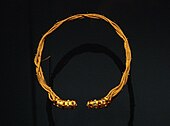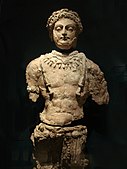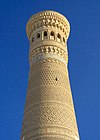
Kanishka I, Kanishka or Kanishka the Great, was an emperor of the Kushan dynasty, under whose reign the empire reached its zenith. He is famous for his military, political, and spiritual achievements. A descendant of Kujula Kadphises, founder of the Kushan empire, Kanishka came to rule an empire extending from Central Asia and Gandhara to Pataliputra on the Gangetic plain. The main capital of his empire was located at Puruṣapura (Peshawar) in Gandhara, with another major capital at Mathura. Coins of Kanishka were found in Tripuri.

The Kushan Empire was a syncretic empire formed by the Yuezhi in the Bactrian territories in the early 1st century. It spread to encompass much of what is now Uzbekistan, Afghanistan, Pakistan, and Northern India, at least as far as Saketa and Sarnath, near Varanasi, where inscriptions have been found dating to the era of the Kushan emperor Kanishka the Great.
The Indo-Parthian Kingdom was a Parthian kingdom founded by Gondophares, and active from 19 CE to c. 226 CE. At their zenith, they ruled an area covering parts of eastern Iran, various parts of Afghanistan and the northwest regions of the Indian subcontinent. The rulers may have been members of the House of Suren, and the kingdom has even been called the "Suren Kingdom" by some authors.

Termez is the capital of Surxondaryo Region in southern Uzbekistan. Administratively, it is a district-level city. Its population is 182,800 (2021). It is notable as the site of Alexander the Great's city Alexandria on the Oxus, as a center of early Buddhism, as a site of Muslim pilgrimage, and as a base of Soviet Union military operations in Afghanistan, accessible via the nearby Hairatan border crossing.
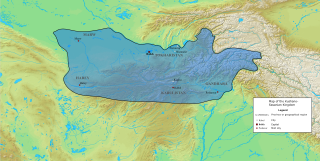
Kushano-Sasanian Kingdom was a polity established by Sasanian Persians in Bactria during the 3rd and 4th centuries CE. The Sasanian Empire captured the provinces of Sogdiana, Bactria and Gandhara from the declining Kushan Empire following a series of warsin 225 CE. The local Sasanian governors then went on to take the title of Kushanshah or "King of the Kushans", and to mint their own coins. They are sometimes considered as forming a "sub-kingdom" inside the Sasanian Empire. This administration continued until 360-370 CE, when the Kushano-Sasanians lost much of their domains to the invading Kidarite Huns, whilst the rest was incorporated into the imperial Sasanian Empire. Later, the Kidarites were in turn displaced by the Hephthalites. The Sasanians were able to re-establish some authority after they destroyed the Hephthalites with the help of the Turks in 565, but their rule collapsed under Arab attacks in the mid 7th century.

Khalchayan is an archaeological site, thought to be a small palace or a reception hall, located near the modern town of Denov in Surxondaryo Region of southern Uzbekistan. It is located in the valley of the Surkhan Darya, a northern tributary of the Oxus.

Indo-Greek art is the art of the Indo-Greeks, who reigned from circa 200 BCE in areas of Bactria and the Indian subcontinent. Initially, between 200 and 145 BCE, they remained in control of Bactria while occupying areas of Indian subcontinent, until Bactria was lost to invading nomads. After 145 BCE, Indo-Greek kings ruled exclusively in parts of ancient India, especially in Gandhara, in what is now present-day the northwestern Pakistan. The Indo-Greeks had a rich Hellenistic heritage and artistic proficiency as seen with the remains of the city of Ai-Khanoum, which was founded as a Greco-Bactrian city. In modern-day Pakistan, several Indo-Greeks cities are known such as Sirkap near Taxila, Barikot, and Sagala where some Indo-Greek artistic remains have been found, such as stone palettes. Some Buddhist cultural objects related to the Indo-Greeks are known, such as the Shinkot casket. By far the most important Indo-Greek remains found are numerous coins of the Indo-Greek kings, considered as some of the most artistically brilliant of Antiquity. Most of the works of art of the Greco-Buddhist art of Gandhara are usually attributed to the direct successors of the Indo-Greeks in Ancient India in the 1st century CE, such as the nomadic Indo-Scythians, the Indo-Parthians and, in an already decadent state, the Kushans. Many Gandharan works of art cannot be dated exactly, leaving the exact chronology open to interpretation. With the realization that the Indo-Greeks ruled in India until at least 10-20 CE with the reign of Strato II in the Punjab, the possibility of a direct connection between the Indo-Greeks and Greco-Buddhist art has been reaffirmed recently.

Takht-i Sangin is an archaeological site located near the confluence of the Vakhsh and Panj rivers, the source of the Amu Darya, in southern Tajikistan. During the Hellenistic period it was a city in the Greco-Bactrian kingdom with a large temple dedicated to the Oxus, which remained in use in the following Kushan period, until the third century AD. The site may have been the source of the Oxus Treasure.

Dilberjin Tepe, also Dilberjin or Delbarjin, is the modern name for the remains of an ancient town in modern (northern) Afghanistan. The town was perhaps founded in the time of the Achaemenid Empire. Under the Kushan Empire it became a major local centre. After the Kushano-Sassanids the town was abandoned.
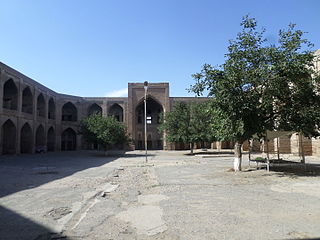
Denov is a city in Surxondaryo Region of southeast Uzbekistan, the administrative centre of Denov District. It is in the Hissar Range close to the border with Tajikistan, and is the closest major town to the Kalchayan and Dalverzin Tepe archaeological sites. Denov is believed to be the site of ancient city of Chaghaniyan.

Kara Tepe is a Buddhist archaeological site in the Central Asia region of Bactria, in the Termez oasis near the city of Termez in southern Uzbekistan. The foundations of the site date to the 1st century CE, with a peak of activity around the 3rd and 4th centuries during the Kushan period, before experiencing a fatal decline around the 5th century CE, probably with the invasion of the Kushano-Sassanian, whose coinage can be found on the site.

Gandhāran Buddhism refers to the Buddhist culture of ancient Gandhāra which was a major center of Buddhism in northwestern Pakistan from the 3rd century BCE to approximately 1200 CE. Ancient Gandhāra corresponds to modern day north Pakistan, mainly the Peshawar valley and Potohar plateau as well as Afghanistan's Jalalabad. The region has yielded the Gandhāran Buddhist texts written in Gāndhārī Prakrit the oldest Buddhist manuscripts yet discovered. Gandhāra was also home to a unique Buddhist artistic and architectural culture which blended elements from Indian, Hellenistic, Roman and Parthian art. Buddhist Gandhāra was also influential as the gateway through which Buddhism spread to Central Asia and China.

Kushan art, the art of the Kushan Empire in northern India, flourished between the 1st and the 4th century CE. It blended the traditions of the Greco-Buddhist art of Gandhara, influenced by Hellenistic artistic canons, and the more Indian art of Mathura. Kushan art follows the Hellenistic art of the Greco-Bactrian Kingdom as well as Indo-Greek art which had been flourishing between the 3rd century BCE and 1st century CE in Bactria and northwestern India, and the succeeding Indo-Scythian art. Before invading northern and central India and establishing themselves as a full-fledged empire, the Kushans had migrated from northwestern China and occupied for more than a century these Central Asian lands, where they are thought to have assimilated remnants of Greek populations, Greek culture, and Greek art, as well as the languages and scripts which they used in their coins and inscriptions: Greek and Bactrian, which they used together with the Indian Brahmi script.
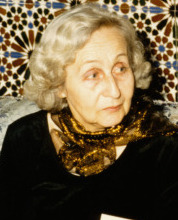
Galina Anatolevna Pugachenkova was a Soviet archaeologist and art historian, regarded as a founder of Uzbek archaeology and central to the progression of archaeology and art history under Soviet regimes. Her work has contributed greatly to the register of surviving buildings in Central Asia and in many cases was the first register of traditional surviving buildings. G. A. Pugachenkova directed a branch of the archaeological expedition of southern Turkmenistan from 1946 to 1961, and of the Uzbek historical-artistic expedition from 1959 to 1984.

Toprak-Kala, in modern Karakalpakstan, Uzbekistan, was an ancient palace city and the capital of in Chorasmia in the 2nd/3rd century CE, where wall paintings, coins and archives were discovered. Its history covers a period from the 1st to the 5th century CE. It is part of the "Fifty fortresses oasis" in modern-day Uzbekistan.
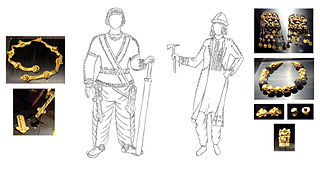
Yemshi Tepe, also Emchi-Tepe or Imshik, is an ancient circular fortress in Afghanistan, 5 kilometers to the northeast of the city of Sheberghan.It is about 100 kilometers west of Balkh, the capital of ancient Bactria.
Kampir Tepe is an archaeological site located within the Surxondaryo Region of Uzbekistan, near the village Shoʻrob, northwest of the city of Termez. It is thought to be the lost city of Alexandria on the Oxus described by Ptolemy, though the Amu Darya river has now changed its course. The Telegraph newspaper describes Kampir Tepe as “the Pompeii of Central Asia.”

Tepe Sardar, also Tapa Sardar or Tepe-e-Sardar, is an ancient Buddhist monastery in Afghanistan. It is located near Ghazni, and it dominates the Dasht-i Manara plain. The site displays two major artistic phases, an Hellenistic phase during the 3rd to 6th century CE, followed by a Sinicized-Indian phase during the 7th to 9th century.

Tapa Shotor, also Tape Shotor or Tapa-e-shotor, was a large Sarvastivadin monastery near Hadda, Afghanistan, and is now an archaeological site. According to archaeologist Raymond Allchin, the site of Tapa Shotor suggests that the Greco-Buddhist art of Gandhara descended directly from the art of Hellenistic Bactria, as seen in Ai-Khanoum.

The chamail is a type of poncho-like clothing from Central Asia.







